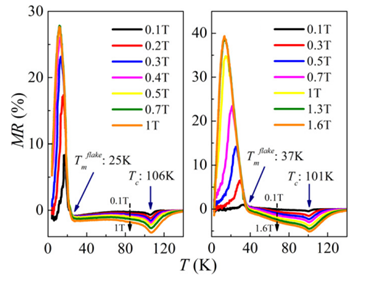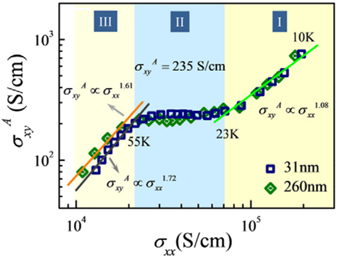Ruthenium oxide perovskites Srn+1RunO3n+1 (n=1, 2, 3, ∞) are strongly correlated materials involving complex interactions between the charge, spin, orbit and lattice degrees of freedom. Their ground states present a rich of exotic physical properties, such as the spin-triplet superconductivity, the quantum criticality, nematicity and spin density wave, etc.Sr4Ru3O10
is the n=3 member of the Srn+1RunO3n+1 family, which is first synthesized by Prof. CAO Gang in 1997. One of the notable characteristics of this member is its magnetic properties. For a field along the c-axis, it displays spontaneous itinerant ferromagnetism at a Curie temperature Tc of about 105K, while for a field within the ab plane it features a metamagnetic transition at a temperature Tm of about 50K. Though the magnetism in Sr4Ru3O10 has been extensively studied, the magnetic nature below Tm
remains unclear and elusive.
Recently, a study team led by Prof. TIAN Mingliang in High Magnetic Field Laboratory, Chinese Academy of Sciences (CHMFL) exfoliated the Sr4Ru3O10 into nano-flakes and studied their magnetic phase by transport measurement through the collaboration with Prof. CAO Gang in the University of Kentucky.
By the study, they found that metamagnetic transition temperature Tmflake
decreased with the decreasing thickness (Fig.1), while the ferromagnetic (FM) phase, the ordinary, and anomalous Hall effects (OHE and AHE) are independent on the thickness of the flake.
Moreover, analysis of the data demonstrates that the decrease of the metamagnetic transition temperature cannot be attributed to the change of the electronic or lattice structures considered previously, but can be understood by the shape anisotropy induced rearrangement of the Ru moments due to the size effect.
Furthermore, it has been found that the scale relation xy
A∝ xx
( xyA is the anomalous Hall conductivity, xx is the longitudinal conductivity) of the anomalous Hall effect in Sr4Ru3O10 can be categorized into three regions with an exponent of =1, 0 and 1.6 (Fig. 2).
All these scaling behaviors are theoretically expected under different scenarios of scattering, but it is rare to observe all these three scaling behaviors in the same sample. This observation indicates an unusual spin scattering mechanism in this material.
Their work has been published in New J. Phys., with the title Size effect on the magnetic phase in Sr4Ru3O10.
And this work was supported by the National Natural Science Foundation of China, the CAS/SAFEA international partnership program for creative research teams of China, etc.
|

|
|
Fig.1 The magnetoresistivity MR of Sr4Ru3O10 flakes as a function of temperature T under various in-plane magnetic fields. The Curie temperature Tc remains unchanged while the metamagnetic transition temperature Tmflake decreases significantly with decreasing thickness. (Image by YANG Jiyong) |
|

|
|
Fig.2 The scaling relation between the anomalous Hall conductivity xyA and the longitudinal conductivity xx. (Image by YANG Jiyong) |